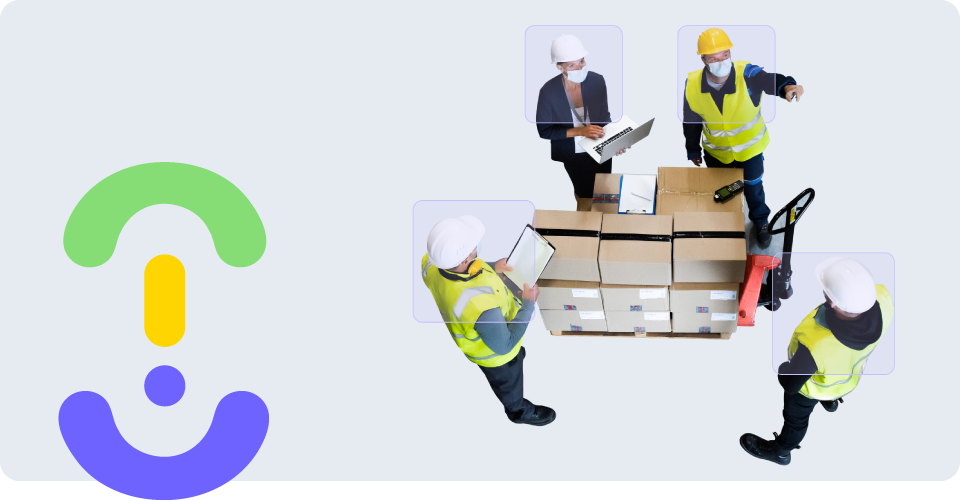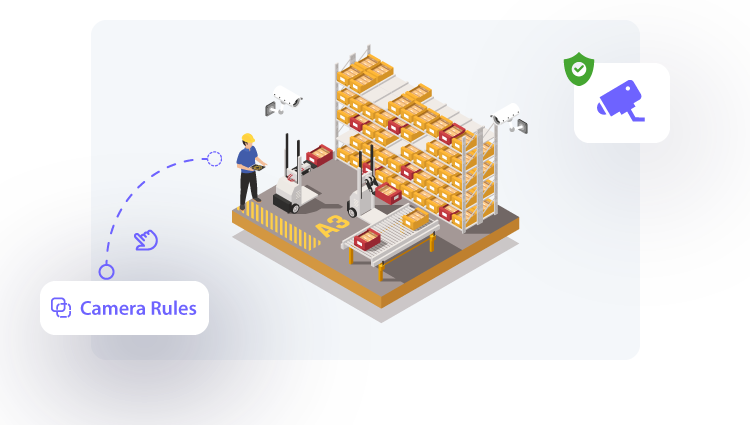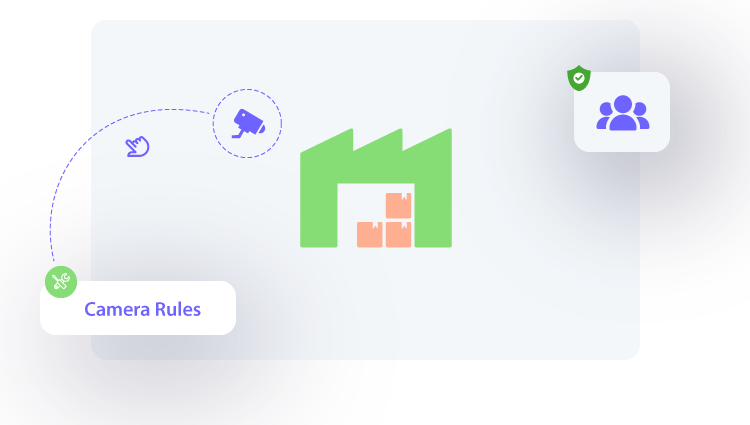How Digital Forms and Video Analytics Improve Safety


- 08.02.2022
- Digital Forms, Video Analytics

Artificial intelligence (AI) and machine learning (ML) tools need access to high-quality data to identify trends and make accurate predictions.
When it comes to operational safety, paper-based forms and manually entered data are often inadequate in generating the insights leaders need to prevent incidents before they occur. As a result, the safety industry is increasingly turning to digital forms, like those in mobile apps, and new video analytics techniques, to supply the required data.
Active data collection with specialized digital forms means data can be easily collected, analyzed, and stored by frontline workers, job-site supervisors, and EHS&Q leaders. Digital forms also provide the benefit of advanced features not available on paper forms. Document management, annotations, real-time signatures, contextual frontline training are some intuitive features that reduce the time required for engaging workers to ensure workflow completion.
Passively collection data through existing facility cameras can give organization’s access to a significantly higher volume of data for informing EHS&Q plans and policies. Augmenting data collecting with IoT devices such as cameras, sensors, drones, PLCs etc. can give organization’s access to high quality data that is largely independent of human involvement.
To better understand the specific value that digital forms and video analytics bring to frontline safety, this article explores the history of safety and recommends some effective ways to apply data-driven decision making to safety operations.
The Movement Toward Digital and AI Solutions
The concept of worker safety is relatively new in the grand scheme of things. From the perspective of frontline EHS&Q, the passing of the Occupational Safety and Health Act (OSH Act) of 1970 in the USA marked the beginning of federally regulated, worker-focused safety efforts. This was followed shortly by the creation of Occupational Safety and Health Administration (OSHA) and National Institute for Occupational Safety and Health (NIOSH).
At the time of its inception, OSHA and the OSH Act were focused primarily on addressing the most at-risk workers, which specifically meant dealing with the short- and long-term exposure hazards that chemical handling posed to workers. At this time, EHS&Q activities were strictly paper-based, and safety documentation was just starting to become more essential to the workplace. For instance, by 1987 OSHA required that all employers provide their workers with access to Materials Safety Data Sheets (MSDS) for the first time. This important step was still a far cry from the “smart” digital technologies we are making use of today.
As technology in the workplace advanced, the widespread adoption of computers and the internet in the 1990s and early 2000s allowed for the first digital safety programs to begin evolving. Practices for digital records retention, early digital forms, and data management in spreadsheets allowed workplace EHS&Q to begin moving into the digital age. Changing expectations created an even greater emphasis on the importance of EHS&Q practices, and the development of new technologies meant that EHS&Q solutions shifted from being strictly compliance-focused and reactive to being proactive.
Now in the 2020s, as a result of the growing adoption of AI technology, we see the development of the first “smart” safety programs. Workplaces are now employing the use of AI and ML to prevent incidents before they occur. This means that companies need to capture and analyze the right data. Digital forms and video analytics are two of the most important tools in collecting data for use by AI and ML tools so that they can make accurate, actionable safety predictions. The future of operational safety, quality, and productivity is data driven.

Understanding Digital Forms and Video Analytics
Digital forms are a commonly used tool for entering EHS&Q-related data into a prepared template for digital submission, analysis, and storage. These act as a replacement for paper-based safety forms, and can include anything from field-level hazard assessments (FLHAs) and equipment inspections to near miss and incident reports. The best digital forms are well-structured so that data can be easily collected from workers and then analyzed by reporting systems.
Digital forms often offer two major advantages over paper-based EHS&Q systems:
1. improved data quality and
2. improved data accessibility.
Paper-based systems are prone to being lost, damaged, illegible, or even incorrectly and incompletely filled out. Digital forms on the other hand are readily available for access and completion on mobile devices in the field thanks to cloud storage, and can be equipped with data quality measures like required responses, dropdown menus, and even spellchecks.
Digital forms means workers, job-site supervisors, and EHS&Q professionals have easy access to a full range of documents without needing to carry around a safety binder or document package. The improved accessibility to data offered by digital forms does not just include the human component, however, as digital forms can also provide AI systems with instant access to cloud-stored data. This means digital forms can be used to inform EHS&Q decision-making in near real-time while also eliminating the need to manually upload and analyze data, which can introduce the potential for data transfer errors.
While digital forms improve the ability to collect and access EHS&Q data from humans, video analytics collect data passively, without the need for human involvement. Video analytics, sometimes referred to as computer vision, for EHS&Q applications covers the capability of AI tools to analyze a live or recorded stream from an IP video camera for a variety of potential health, quality, productivity and safety-related events. This analysis can be integrated into one-time or recurring inspections to prevent incidents from occurring. Workers who are not wearing gloves or are entering hazardous areas can be quickly identified and deterred. Audio-visual signals can be used for emergency response analysis, identifying for example if an employee has collapsed and is unresponsive or if a fire has started.
Due to its advanced capabilities as a real-time, passively-collected data source, video analytics is the next step toward improving workplace safety. The lack of human involvement also eliminates the possibility of human error or bias in data collection.
In summary, digital forms and video analytics are best used together. The passive data collection offered by video analytics makes it an excellent addition to existing safety programs that use digital forms to take advantage of human insights. Workplaces that promote excellent worker engagement and participation in the safety programs can benefit from the additional video analytics data to drive continuous improvement.
How can Digital Forms & Video Analytics Improve Frontline EHS?
Digital forms and video analytics can aid frontline EHS programs in a number of key areas. Honing a workplace’s safety culture to improve safety performance, using a data-driven approach to EHS&Q, and addressing incidents in real-time all contribute to a more successful frontline EHS program.
Improving safety culture through employee engagement and increased reporting
It is widely accepted that workplaces with a strong safety culture correspond with improved safety performance, meaning lower incident frequency and severity. The key to this is the relationship between unsafe behaviors and their eventual safety consequences, which is also illustrated by models such as Heinrich’s Safety Pyramid. Improving safety culture to address these unsafe behaviors early on therefore needs to be a priority of safety programs.
While tackling safety culture is a complex issue, two vital aspects for improving safety culture are better employee engagement and improved reporting and tracking. Digital forms and video analytics are helpful in both these areas, though video analytics shows the most potential when it comes to compliance tracking.
Looking just at the applications for digital forms, they are very useful for developing accountability among both teams of workers and independent workers, engaging them to promote a positive safety culture. Digital forms can be used to facilitate behavior-based safety observations (BBSOs) for example, which encourage workers to be mindful of the work going on around them in order to identify if specific actions agree with what should take place in a truly safe work environment. This could mean inspecting the conditions of one’s personal protective equipment (PPE), noting whether coworkers use good form when lifting heavy items, or observing whether a workspace is kept tidy and free of clutter.
Generally speaking, paper forms could be valuable for encouraging these kinds of behavior as well, however, the ability to use digital forms almost anywhere means workers do not have to worry about running out of documents or about them becoming damaged at the jobsite. They also provide the ability to integrate dependent questions that only appear for certain responses, the ability to capture and attach photos, and prompts to encourage workers to acknowledge unsafe behaviors they may otherwise overlook. For example, a digital field level hazard assessment (FLHA) with well-structured navigation could encourage workers normally focused on only major hazards such as overhead power or heavy equipment operations to also consider smaller threats, such as uneven or slippery surfaces that could lead to a slip, trip, or fall incident. In this way, the digital form can take advantage of a clever user interface (UI) to keep workers engaged and ensure they do not skip steps. If a slip/trip/fall hazard is identified, a digital form can then prompt workers to cordon off the area or install hazard markers, such as yellow caution tape, and then ask them to confirm that this is done prior to starting work.
Digital forms also clearly outmatch paper-based forms when it comes to tracking and reporting. Not only do they upload responses directly for immediate access by AI systems, but they also limit tampering. Take an inspection log for example, which could be set up to require that workers complete certain steps in order and confirm them with required photos. Once the record is finalized and submitted, it can automatically be sent off for secure, audit-ready storage with an accompanying timestamp.
Digital forms for FLHAs, inspection logs, and other safety documentation also means notifications can be sent to the appropriate team members so that they can ensure compliance with EHS&Q requirements. For example, notifying an area operator or jobsite supervisor when all pre-work checks and documentation are completed, so that, if equipment is operating without the proper documentation and safety precautions, they can address it before an incident occurs.
While digital forms are a definite improvement for reporting and tracking activities, video analytics provide access to a wealth of new data in these areas. This could include identifying employees not wearing PPE while using sharp tools, or monitoring and flagging issues like restricted area access and employee proximity to hazardous equipment or hazardous areas. All of these accumulated metrics help to not only inform jobsite supervisors and local EHS&Q team members of specific, actionable measures needed to address immediate safety risks, but they also inform top management and EHS&Q leaders of widespread trends and the areas of interest for future safety campaigns.
While video analytics is primarily useful for this kind of compliance tracking, the information collected here can also be used for identifying and engaging workers in their own safety. By identifying specific, actionable items, such as an employee who crosses a high traffic area as a shortcut instead of using designated crossing areas, video analytics can prompt management to stop the unsafe behavior before it becomes a habit, such as by sending the employee for specific safety training. This also then prevents the habit from normalizing with other employees and encourages them to watch for similar unsafe behaviors.

Developing data-driven EHS plans
Data needs to be at the center of EHS&Q planning and policy-making to generate the most valuable impact. By basing decisions on the data, managers and EHS&Q leaders can ensure they target the right areas for improvement in the right ways. With traditional paper-based systems and manual data entry and analysis techniques, data is frequently lost, transferred incorrectly, or misinterpreted during analysis, all of which could mean an incomplete or erroneous picture of the state of a jobsite’s EHS systems.
Digital forms and video analysis, however, both lead to increases in data collection, data reliability, and the automation of the analysis and interpretation process. Intuitively designed digital forms increase accessibility, giving workers access to all the documents they need in one place, prompting them to complete all required fields, including uploading photos if needed. This means workers are more likely to enter the correct data in the correct form. In this way, digital forms increase data collection rates and data reliability, while limiting data transfer errors and record loss.
While digital forms are an improvement over older paper-based systems, they function in a very similar way. Workers input safety data manually, the data is stored such that it can later be recalled, and then the data is analyzed, either manually or through the use of “smart” software. Based on the results of the manual analysis, or preferably analysis by an AI system, trends and areas for improvement are identified so that action can be taken. Video analysis, however, removes the human element entirely, providing access to a previously untapped source of data.
This additional data stream in the form of recorded or, preferably, live video, can be combined with trained AI systems to manage the autonomous collection and analysis of data, even generating actionable steps for jobsite supervisors, managers, and EHS&Q leaders. The real value of computer vision is that it does not replace any other data channel, it only adds to the bank of valuable information decision-makers need to make impactful changes to safety culture and safety performance.
Real-time incident prediction and emergency response monitoring
In the same way that video analytics adds a new, untapped data channel for informing EHS&Q policy-making over time, they can also be combined with live video feeds to inform rapid responses to safety hazards and ongoing incidents. This is a relatively new area of potential, but the possibilities clearly demonstrate the value of both real-time incident prediction and emergency response management.
When it comes to managing ongoing emergencies, video analytics can be used to detect incidents like collapsed workers or the outbreak of a fire at the job-site. The AI system, upon detecting one of these incidents, would then notify the appropriate pre-established personnel, such as the job-site supervisor and EHS&Q manager, so that they could respond swiftly and with all the information they need. If desired, this system can even be set up as a semi-automated emergency response plan (ERP) so that, depending on the type of incident detected, notifications are sent to the appropriate individuals who can then escalate the response, or, if the notification recipient does not respond within a certain time-frame, the event will be automatically escalated. This can be used to ensure incidents and emergencies are addressed in a timely manner and that the appropriate individuals are informed, even dispatching the appropriate emergency responders if required.
While the value of video analytics for informing emergency responses is obvious, the leaders of job-site safety are using computer vision to flag potential incidents before they occur. The AI behind video analytics can be trained to identify any number of potential safety threats, from unsafe worksite behaviors to abandoned equipment. With video analytics, job-site supervisors and EHS&Q personnel can be instantly notified on their mobile devices if a safety threat or unsafe behavior is identified.
What the Future Holds
The history of frontline EHS&Q clearly demonstrates that industries are experiencing ever-increasing demands to exhibit outstanding safety performance and a strong safety culture so that they can stay competitive. For managers and EHS&Q leaders that want to stay ahead of the curve going forward, they need to implement digital forms and video analytics technology as soon as possible, if they have not done so already.
The transition to digital forms and cloud-based services can be a time-consuming process for those companies with extensive paper-based and server-stored safety documentation, however, the transition only becomes more difficult with time. One example shows that over the decade between 2004 and 2014, the largest architecture, engineering, and construction projects have grown to generate 65 times the amount of EHS&Q data that they once did. With the growing amount of EHS&Q documentation required, it makes the most sense to begin going digital now.
While transitioning to digital forms may be challenging for those businesses operating on a more traditional system, the adoption of video analytics may seem even more daunting. This is especially true in the construction industry, where the job-site is ever-changing. However, the clear value of video analytics for accelerating safety performance warrants coming up with creative approaches. For contractors that have already begun implementing video cameras at worksites, the integration of video analytics software with existing infrastructure becomes much simpler and more cost-effective, making it the logical next step for these forward-facing EHS&Q programs.
The collection and analysis of big data by AI systems is the key to having a top-notch EHS&Q program for the future, making your business competitive as both social pressure and client expectations for safety performance increase.
Some case studies from industries showing the successful implementation of these types of technologies include:
● The implementation of video analytics at the Jackson Hole Airport can be used to investigate missing baggage, identify personnel entering restricted areas, and more
● The integration of city-wide traffic surveillance systems that can detect near-collision incidents and traffic flow in real-time in order to inform city planners and traffic operations
● The adoption of video analytics for a train station in Romania, which allowed for passenger counting, fire detection, intrusion detection, and more.
● The installation of camera and video-analytics systems across multiple power substations to identify intruders and send notifications to the control center, identifying both vehicles and people
● The use of cameras mounted on Komatsu equipment to monitor surrounding people and equipment in order to prevent collisions.
● The integration of video analytics with the camera network at a steel manufacturer identifies bad ergonomics and unsafe behaviors in order to improve safety performance
● The adoption of digital forms by Cahill Contractors LLC lead to improved safety performance and quality tracking
Knowella AI Inc. offers an industry-leading digital solution to managing EHS&Q. We provide workers, supervisors, EHS&Q professionals, and top-level management the tools they need to improve workplace safety. We use AI-powered data analysis to optimize your approach to EHS&Q, resulting in lower operating costs and quantifiable improvements to your safety performance.
- 08.02.2022

Businesses can obtain certification in a standard for occupational health and safety management in order to prevent and reduce onsite work accidents…